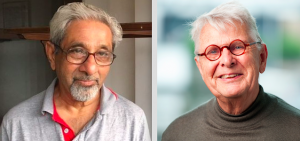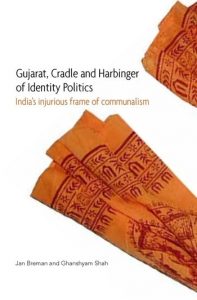
A new book by two veteran academics, “Gujarat, Cradle and Harbinger of Identity Politics: India’s Injurious Frame of Communalism”, perhaps for the first time traces the roots of inter-religious strife leading to Hindutva’s political hold today, pointing towards the role played by so-called upper castes in a State known during the Independence movement for its composite culture — though not without strong undercurrent of majoritarianism.
Authored by Jan Breman, professor emeritus of comparative sociology at the University of Amsterdam; and Ghanshyam Shah, retired professor, Jawaharlal Nehru University, New Delhi, and former director, Centre for Social Studies, Surat, and published by Tulika Books, the book gives researched evidence of how the construct of ‘we’ (Hindus) a versus ‘others’ (Muslims and Christians) took shape in Gujarat.
The process took shape following the “inclusion of the lower strata of the society, Dalits, Adivasis and other backward classes (OBCs)”, who were “inculcated with Brahminical values”. This was done to “homogenize the majority Hindu community”, leading to “communal Hindutva politics”, conceptualized as “religion-centric cultural community versus imagined others”, says Prof Shah.
Following Mahatma Gandhi’s call for constructive work, several idealistic youths, mainly from the upper castes (largely Brahmins and Vaniyas, and a few Patidars), and a very tiny middle class, opted to take up ‘seva’ of Dalits, Adivasis and backward castes as their lifelong mission.
While their programmes focused on the spread of education, on economic activities such as spinning, weaving and cottage industries, and on social reforms that included campaigns against the practice of untouchability, customs and rituals practised in everyday life, etc., their ‘social reform’ was embedded in Sanskritization among deprived communities.
While carrying out these programmes, they often evoked religious symbols, rituals and idioms of the community superimposed with Brahminical nuances. They often preached emulation of upper-caste customs as well as religious rituals and morale. “Removal of untouchability was on their agenda; it was however primarily confined to removing the taboo of physical touch rather than socio-economic discrimination and inequality”, says Prof Shah.
No doubt, their prayers and discourses, respect for all religions – Ishwar-Allah – was expressed, and on certain occasions, prayers of the Hindu, Muslim and Christian religions were recited, invoking harmony between different communities and individuals, as for Gandhi, all struggles against the British government were dharma yudhha, i.e. righteous war.
For instance, the Bardoli Satyagraha led by Sardar Vallabhbhai Patel in 1928 was considered as yagna (ritual sacrifice), and people were asked to take a pledge in the name of god to support the struggle. The resolution regarding the undertaking of the Satyagraha was passed in a public meeting accompanied by recitation from the Quran and Hindu hymns.
At the same time, traditional social status and assumed nature of caste/community were eulogized and legitimized. Kshatriyas were persuaded that courage was their inherent character. The relationship between labourers and landlords was legitimized as sacred using the metaphor of a husband-wife relationship in which the latter performs the role of a pativrata (devoted wife), loyal to her husband. Patriarchal and feudal bonds were harped on, maintained and legitimized to preserve social status quo.
There were of course liberal Gandhians, mostly Congress socialists, who believed in plural Hinduism. They were non-practising Hindus or Muslims, and who worked among urban labourers, peasants and bonded labourers for demanding their fair wages and freedom. However, they were “humiliated and marginalized” by Sardar Patel. Though Gandhi was occasionally sympathetic to the views of the socialists, he was helpless to defend them against Patel’s command.
A third stream, which was part of the Congress till the mid-1930s, leaders of the Hindu Mahasabha, in Gandhi’s opinion, were “conservatives” but liberal — “very large-hearted and not anti-Muslim.” Writes Prof Shah, “With the weakening of the Khilafat–Non-Cooperation movement and withdrawal of the call for civil disobedience, this section lost faith in Gandhi’s principles of non-violence and Hindu–Muslim unity.”
While discourse and action related to civil disobedience or constructive work did not interest them, their main focus was restructuring and reorienting Hinduism like other institutionalized religions as conceived by the Arya Samaj, and they used this discourse to counter Islam and Christianity. They also started a campaign for expansion of gymnasiums for Hindu youths to strengthen their physique for self-defence to counter ‘enemies’.
There were, of course, “instances” of like Vasant and Rajab, Hindu and Muslim Congress workers, respectively, losing their lives in Ahmedabad riots in 1946, while trying to prevent the crowd. Some leaders like Darbar Gopaldas Desai in central Gujarat, Dayalji Desai, Jinabhai Desai in Surat, Chamanlal, Manilal Shah, Mehbub Kadari and Mridula Sarabhai in Ahmedabad, criticized the Hindu Mahasabha and Arya Samaj for spreading hatred against Muslims.
Some of them even organized a hartal in Surat protesting the anti-Muslim propaganda of leaders of Hindu groups. They even received the support of Vallabhbhai Patel. “However, such cases were few and far in between. The average Congress worker maintained silence and expressed helplessness”, says Prof Shah. In 1941, Gandhi himself realized the ineffectiveness of Congress workers in maintaining communal unity.
At places, he found them ‘as barbarous as the assailants’, untouched by ‘Congress non-violence’. When the Gujarat Congress secretary asked all those favouring such ‘violent resistance’ to ‘get out of the Congress’, well-known littérateur KM Munshi confessed to Gandhi that he was “not able to convince the numerous Hindus under his influence to defend themselves through ahimsa.”
When Gandhi told Munshi that the Congress was “conceived to be non-violent and truthful, and the Congress policy binds them [Congressmen] to non-violence in the struggle with the government as also in dealing with communal riots and the like”, Munshi resigned from the Congress, and Vallabhbhai Patel was not happy with Gandhi’s stand.
According to Prof Shah, during all these years, there was little involvement of the backward classes, especially Dalits, in whipping up anti-Muslim feelings. The participation of Dalits in the Hindu-Muslim communal riots of 1946, on the eve of the country’s partition, was hardly visible, despite the fact that several Muslims of Ahmedabad, particularly of the upper strata, were pro-Muslim League. Nor were they actively involved in the large-scale 1969 riots, in which 1,500 people, 90% them Muslims, lost their lives.
Following the 1969 riots, RSS became very active, with its number of shakhas multiplying. Even as taking up health relief and income generation welfare programmes on a regular basis, RSS coordinated functions with other Hindu sects like Swaminarayan, Swadhyay, Gayatri Pariwar, Pustimargis, and also, occasionally, caste organizations.
This was followed by what Prof Breman calls “a wheeling-and-dealing type of politicking” of 1980s, propelled by the Congress view that Gujarat’s four major sections — Kshatriyas, Harijans (Dalits), Adivasis and Muslims — would form a “comfortable” political majority. This was more “inspired by a vulgar competition for power”, something the Congress had to give up soon.
The upper-caste intelligentsia – teachers, students, and professionals like doctors and lawyers – launched an agitation when the government raised the reservation quota for OBCs from 10 per cent to 28 per cent. As a result, in 1981–82 and 1985–86, the higher castes in the city protested at the “positive discrimination” from which Dalits and other backward castes (OBCs) especially allegedly benefited.
However, what started as a middle-class campaign against the reservation policy favouring backward castes increasingly turned into a conflict between Hindus and Muslims. What followed were communal riots, in which hundreds died, an outcome of the “changed strategy” of the BJP, which now decided to mobilize rather than antagonize the subaltern castes.

In order to coopt the backward classes and Dalits, “Hindu consciousness” was sought to be invoked and symbols like the sword, trishul and swastika — perceive these as emblems of Hindu identity — began being deployed. This led sections of Dalits and other backward sections to follow the Sanskritization path.
All this happened, opines Prof Shah, against of backdrop of Gujarat lacking any significant number of radical and secular groups – the Left, Gandhians, liberals, socialists, etc. Nor has it witnessed an anti-Brahmin or backward caste movement. The influence of Gandhians who believe in catholic Hinduism, syncretic culture, tolerance and harmony, meanwhile, considerably sank.
The anti-reservation movement turned into communal conflict in other parts of Gujarat, too. In Surat, an orgy of violence broke out in the second week of December 1992, in which Muslims living in the city became the exclusive target amidst the destruction of the Babri Masjid in Ayodhya “by squads of Hindu zealots.” On receiving the news of events in Ayodhya, BJP rank-and-file celebrated the victory of mandir or masjid across Gujarat, including Surat.
“Eyewitnesses told of how already early in the morning on the day after Ayodhya, gangs had assembled in their localities to attack houses and other establishments which were known to be inhabited or owned by Muslims”, says Prof Breman, adding, “The official death toll of this cleansing operation stood at 185, more than half the total score in Gujarat, when I left the city in the middle of January 1993.”
Meanwhile, the call for homogenizing Hindu identity continued. It was found necessary to identify “outsiders” who were neither willing nor able to share in the awareness of the Hindu nation. These were Muslims and secular ‘unbelievers’. In Hindutva ideology, became a class of new untouchables. The hatred previously reserved for the ‘untouchables’ has begun being projected onto them.
“The Hindu ‘untouchables’ themselves, of course, have paid a price for their new ‘dignity’. The violence needed to keep the “others” outside the door was entrusted to those who traditionally found themselves at the bottom of the caste system. Consequently, the Dalits – the ‘oppressed’ – were over-represented in the mobs attacking the Muslims in Ahmedabad during the pogrom of 2002”, says Prof Breman.
Underlines Prof Shah, with rise in unemployment, casualization of labor and criminalization of politics in Gujarat, different social groups – upper and middle castes, Dalits and OBCs – and Gujaratis and non-Gujaratis, were “encouraged” by the ruling sections, including the police, during the 2002 riots – in which officially 1,044 died 223 were missing – to also indulge in looting at several places.
Source- counterview.net, January 30, 2022.




